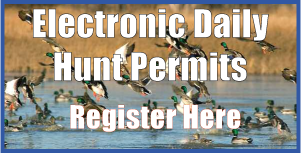REGULATIONS
Regulations governing the take of geeseare set annually. Click the links below for more information.
Goose Season Dates, Bag Limits, and Possession Limits,
Non-Toxic Shot Regulations and Areas,
Legal and Illegal Methods of Take
Transporting
One fully-feathered wing and /or head must remain attached to waterfowl when transported.
Shipment
No person shall ship migratory game birds unless the package is marked on the outside with: 1) the name and address of the person sending the birds, 2) the name and address of the person to whom the birds are being sent, and 3) the number of birds, by species, contained in the package.
Giving or Receiving Waterfowl
No person may receive, possess, or give to another, any freshly killed migratory game birds as a gift, except at the personal abodes of the donor or donee, unless such birds have a tag attached, signed by the hunter who took the birds, stating the hunter’s address, the total number and species of birds, and the date such birds were taken.
Tagging Requirements
No person shall put or leave any migratory game birds at any place (other than at his personal abode), or in the custody of another person for picking, cleaning, processing, shipping, transportation, or storage (including temporary storage), or for the purpose of having taxidermy services performed, unless such birds have a tag attached, signed by the hunter, stating his address, the total number and species of birds, and the date such birds were killed. Migratory game birds being transported in any vehicle as the personal baggage of the possessor are not considered as being in storage or temporary storage.
Electronic or Mechanically Operated Decoys
The use of electronic or mechanically operated decoys that do not produce bird sounds is legal.
Wanton Waste
By regulation, hunters must attempt to find any game crippled or killed. Retrieved animals must be kept until: 1) cleaned, 2) eaten, 3) taken home, 4) taken to a taxidermist or processor, or 5) given to another person.
Possession of Live Birds
Wounded waterfowl reduced to possession shall be immediately killed and included in the daily bag.
Baiting Regulations
Baiting regulations differ between doves and waterfowl, and are among the most troublesome for hunters to understand. For detailed information on waterfowl baiting click on the following web site - http://www.le.fws.gov/HuntFish/waterfowl_baiting.htm
Some general baiting rules that "WATERFOWL" hunters should remember:
- They may not place, expose, deposit, distribute or scatter salt, grain or other feed that could lure waterfowl to, on or over the area where they are hunting.
- They may not hunt a baited area until 10 days after all bait or feed has been completely removed.
- Hunters are responsible for ensuring that the area they plan on hunting has not been baited before they start hunting.
- Hunters may hunt all migratory game birds over natural vegetation that has been mowed or manipulated in other ways, or where seeds or grains have been scattered solely as a result of a normal agricultural planting or normal soil stabilization practice.
- Hunters may use natural vegetation to conceal or construct a blind.
- Hunters may hunt waterfowl over standing crops, standing flooded crops and flooded harvested cropland.
Goose Management Unit Maps
Marais des Cygnes Valley and Southeast Unit Maps
Kansas City Early Goose Zone
Wichita Early Goose Zone








